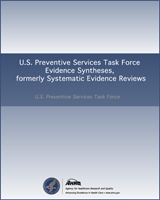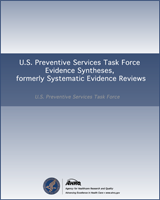NCBI Bookshelf. A service of the National Library of Medicine, National Institutes of Health.
This publication is provided for historical reference only and the information may be out of date.
Structured Abstract
Background:
Evidence indicates that aspirin is effective for the primary prevention of cardiovascular disease (CVD) and colorectal cancer (CRC), but regular use also increases risk for gastrointestinal (GI) and cerebral hemorrhages.
Objective:
To assess the net balance of benefits and harms from routine use of aspirin for primary prevention across clinically relevant age, sex, and CVD risk groups.
Design:
Decision analysis using a microsimulation model.
Data Sources:
Relative risks of aspirin benefits and harms are sourced from three updated systematic evidence reviews.
Target Population:
Men and women aged 40 to 79 years with 10-year CVD risk of 20 percent or less, no history of CVD, and non-elevated risk for GI or cerebral hemorrhage.
Time Horizon:
Lifetime, 20 years, and 10 years.
Perspective:
Clinical.
Intervention:
Daily use of low-dose aspirin (100mg or less).
Outcome Measures:
Primary outcomes are net benefits in terms of life years and quality-adjusted life years (QALYs). Benefits include reduction of non-fatal myocardial infarction, non-fatal ischemic stroke, fatal CVD, CRC incidence, and CRC mortality. Harms include increase in fatal and non-fatal GI bleeding and hemorrhagic stroke.
Results of Base-Case Analysis:
Lifetime net benefits from routine aspirin use for primary prevention are found to be positive for men and women aged 40-69 in all 10-year CVD risk levels. For men and women aged 70-79, lifetime net outcomes are mixed: net life years are negative, but net QALYs are positive. The largest lifetime net benefits from aspirin are found among men and women aged 40-59 with moderate-to-high baseline CVD risk. Net benefits from aspirin over 10 and 20 years of use are generally much lower and may be negative. Net benefit calculations also favor early over delayed initiation of aspirin use for all men and women aged 40-69.
Results of Sensitivity Analysis:
Net benefit results are most sensitive to uncertainty regarding the effect of low-dose aspirin on the increased risk of hemorrhagic stroke and in the primary prevention of CVD mortality. Imposing small disutilities on routine aspirin use can substantially diminish the net benefit of using aspirin to improve overall quality of life.
Limitations:
Sensitivity analyses demonstrate that our current imprecision in understanding aspirin's effects on benefits and harms, when used for primary prevention, carry through to model estimates. Persons aged 40-49 are not as well represented in the studies informing aspirin's effects, and therefore, the modeling results may not reliably apply to persons in this age group. Improved ability to estimate individual GI bleeding risk would enhance precision. Modeled results do not account for potential correlations between CVD risk factors and GI bleeding risk, except for age and sex.
Conclusion:
Benefits are predicted to exceed harms among persons aged 40-69 with non-elevated bleeding risk who take aspirin for primary prevention of CVD and CRC over their lifetimes. Net benefits from routine aspirin use over a 10- or 20-year horizon are expected to be substantially smaller, and in many cases, harms may exceed benefits. Findings do not differ markedly between men and women; however, deterministic and probabilistic sensitivity analyses reveal meaningful uncertainty about the magnitude of net benefit.
Contents
- 1. Introduction
- 2. Methods
- 3. Results
- KQ 1a What Is the Lifetime Net Benefit of Aspirin?
- KQ 1b What Is the Net Benefit of Aspirin Over 20 Years?
- KQ 1c What Is the Net Benefit of Aspirin Over 10 Years?
- KQ 2 What Is the Marginal Net Benefit of Initiating Aspirin Now Versus Waiting 10 Years?
- Deterministic (One-Way) Sensitivity Analyses (KQs 1a–c)
- Probabilistic Sensitivity Analyses (KQs 1a–c)
- 4. Discussion
- References
- Appendix A
- Appendix B Model Technical Documentation
- Addendum
Acknowledgments: The authors acknowledge the following individuals for their contributions to this project: Robert McNellis, PA, MPH, at AHRQ; current and former members of the U.S. Preventive Services Task Force who contributed to topic deliberations; Evelyn P. Whitlock, MD, MPH, Janelle M. Guirguis-Blake, MD, Jessica Chubak, PhD, MBHL, Melissa L. Anderson, MS, Tracy Beil, MS, Diana S.M. Buist, PhD, MPH, Brittany U. Burda, MPH, Corinne V. Evans, MPP, Alisha Feightner, MPH, Aruna Kamineni, PhD, MPH, Elizabeth A. O'Connor, PhD, Maya G. Rowland, MPH, Caitlyn A. Senger, MPH,and Selvi B. Williams, MD, MPH, with the Kaiser Permanente Research Affiliates EPC; and Amy B. LaFrance, MPH, and Logan H. Stuck, MS, at the HealthPartners Institute for Education and Research.
Prepared for: Agency for Healthcare Research and Quality, U.S. Department of Health and Human Services1, . Contract No. HHSA-290-2012-00015-4, Task Order No. 4. Prepared by: Kaiser Permanente Research Affiliates Evidence-based Practice Center2,
Suggested citation:
Dehmer SP, Maciosek MV, Flottemesch, TJ. Aspirin Use to Prevent Cardiovascular Disease and Cancer: A Decision Analysis. AHRQ Publication No. 15-05229-EF-1. Rockville, MD: Agency for Healthcare Research and Quality; 2015.
This report is based on research conducted by the Kaiser Permanente Research Affiliates Evidence-based Practice Center (EPC) under contract to the Agency for Healthcare Research and Quality (AHRQ), Rockville, MD (Contract No. HHSA-290-2012-00015-4, Task Order No. 4). The findings and conclusions in this document are those of the authors, who are responsible for its contents, and do not necessarily represent the views of AHRQ. Therefore, no statement in this report should be construed as an official position of AHRQ or of the U.S. Department of Health and Human Services.
The information in this report is intended to help health care decisionmakers—patients and clinicians, health system leaders, and policymakers, among others—make well-informed decisions and thereby improve the quality of health care services. This report is not intended to be a substitute for the application of clinical judgment. Anyone who makes decisions concerning the provision of clinical care should consider this report in the same way as any medical reference and in conjunction with all other pertinent information (i.e., in the context of available resources and circumstances presented by individual patients).
This report may be used, in whole or in part, as the basis for development of clinical practice guidelines and other quality enhancement tools, or as a basis for reimbursement and coverage policies. AHRQ or U.S. Department of Health and Human Services endorsement of such derivative products may not be stated or implied.
None of the investigators have any affiliations or financial involvement that conflicts with the material presented in this report.
- 1
540 Gaither Road Rockville, Maryland 20850; www
.ahrq.gov - 2
Kaiser Permanente Center for Health Research, Portland, OR
- Review Aspirin Use to Prevent Cardiovascular Disease and Colorectal Cancer: An Updated Decision Analysis for the U.S. Preventive Services Task Force[ 2022]Review Aspirin Use to Prevent Cardiovascular Disease and Colorectal Cancer: An Updated Decision Analysis for the U.S. Preventive Services Task ForceDehmer SP, O’Keefe LR, Grossman ES, Maciosek MV. 2022 Apr
- Aspirin for the Primary Prevention of Cardiovascular Disease and Colorectal Cancer: A Decision Analysis for the U.S. Preventive Services Task Force.[Ann Intern Med. 2016]Aspirin for the Primary Prevention of Cardiovascular Disease and Colorectal Cancer: A Decision Analysis for the U.S. Preventive Services Task Force.Dehmer SP, Maciosek MV, Flottemesch TJ, LaFrance AB, Whitlock EP. Ann Intern Med. 2016 Jun 21; 164(12):777-86. Epub 2016 Apr 12.
- Aspirin Use to Prevent Cardiovascular Disease and Colorectal Cancer: Updated Modeling Study for the US Preventive Services Task Force.[JAMA. 2022]Aspirin Use to Prevent Cardiovascular Disease and Colorectal Cancer: Updated Modeling Study for the US Preventive Services Task Force.Dehmer SP, O'Keefe LR, Evans CV, Guirguis-Blake JM, Perdue LA, Maciosek MV. JAMA. 2022 Apr 26; 327(16):1598-1607.
- Review Aspirin Use in Adults: Cancer, All-Cause Mortality, and Harms: A Systematic Evidence Review for the U.S. Preventive Services Task Force[ 2015]Review Aspirin Use in Adults: Cancer, All-Cause Mortality, and Harms: A Systematic Evidence Review for the U.S. Preventive Services Task ForceWhitlock EP, Williams SB, Burda BU, Feightner A, Beil T. 2015 Sep
- Review Aspirin Use to Prevent Cardiovascular Disease and Colorectal Cancer: An Evidence Update for the U.S. Preventive Services Task Force[ 2022]Review Aspirin Use to Prevent Cardiovascular Disease and Colorectal Cancer: An Evidence Update for the U.S. Preventive Services Task ForceGuirguis-Blake JM, Evans CV, Perdue LA, Bean SI, Senger CA. 2022 Apr
- Aspirin Use to Prevent Cardiovascular Disease and Colorectal CancerAspirin Use to Prevent Cardiovascular Disease and Colorectal Cancer
- 3small be, Cyrillic.capital PE, CyrillicOP ENG (0)BioProject
- 3capital E, Cyrillic.opBeta (0)BioProject
- 2OPintegral, OPsmall en, CyrillicOP (1382)BioProject
Your browsing activity is empty.
Activity recording is turned off.
See more...

